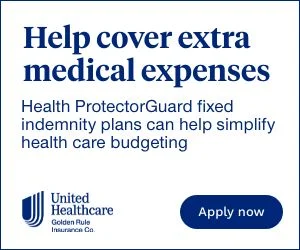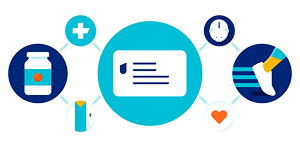Your grandfather died of a heart attack, and your dad has high blood pressure. Does this mean you’re doomed to heart disease too? While family history does play a role in your future heart health – it’s not the deciding factor. In fact, there’s plenty you can do to reduce your risk, even if your DNA feels stacked against you.
Some good news: If you catch heart disease early, it’s much easier to treat. Why is it important to catch it early on? Because it’s the leading cause of death among men and women in the U.S., killing nearly 700,000 people a year.
That means nearly all of us can do more to protect our hardest-working muscle. And you don’t have to change your life too much to make a difference.
Here are 8 things you can do to keep your heart pumping for the long haul.
Before you get started, it’s a good idea to find a health insurance plan that’s right for you. Learn more about your insurance options here.
1. Rinse your canned beans and vegetables before eating them
Yes, you read that right. By thoroughly rinsing and draining canned beans, vegetables, and even tuna fish before eating, you’ll reduce the amount of sodium – or salt – in them.
High sodium intake is associated with increased blood pressure, which is a risk factor for heart disease. Americans average 3,400 mg of sodium each day. That’s more than the 2,300 mg (1 teaspoon) limit recommended in the Dietary Guidelines for Americans 2020-2025 from the USDA.
And most of that salt doesn’t come from your shaker.
“The majority of sources of sodium are coming from highly processed foods and restaurants and carryout,” says Maggie Neola, a registered dietitian. Neola is a community nutrition program manager for the Physicians Committee for Responsible Medicine in Washington, D.C.
2. Pick 1 meat to swap out of rotation
“When a young, healthy patient comes in and wants to know the recommendation for the ‘best’ cardiac diet, I suggest a plant-based diet,” says Sloane McGraw, D.O. Dr. McGraw is an adult cardiologist at Metropolitan Heart & Vascular Institute in Coon Rapids, Minnesota.
“There has been much data on the success of this diet with reduction in coronary disease and cholesterol. This is a huge lifestyle change for most Americans, so I recommend starting small,” says Dr. McGraw.
One strategy is to look at what you typically eat and pick 1 animal food to eliminate, says Dr. McGraw. For example, you could choose not to eat breakfast sausage anymore. Another option would be to replace a serving of chicken or steak with a serving of plant foods once a week. And then twice a week and so on.
3. Eat a banana every day
Taking on a heart-healthy diet doesn’t always have to mean eliminating foods. You need to add the right ones too. On the list: potassium-rich foods such as bananas, dark leafy greens, mango, tomatoes, lentils, sweet potatoes, and avocado.
Higher levels of potassium can help keep your sodium levels in check, which helps your blood pressure too, says Neola.
4. Go for a walk, inside or outdoors
Your eventual goal can be to get your heart rate up for 30 minutes, 5 days a week. But that doesn’t mean you have to start there, especially if you spend a lot of time sitting in front of a computer screen all day.
“The key is always that you must start somewhere,” says Dr. McGraw. “Get up and walk around the house for 10 minutes, 2 to 3 times per day. Then increase it to 15 minutes and so on.”
Once it’s routine, you can add on more time in the neighborhood or hit the treadmill at the gym.
While you’re out walking, call a licensed insurance agent at 1-800-273-8115 to talk about your health insurance options.
5. Write down what you’re eating
Writing down what you eat throughout the day – or keeping a log of it on a smartphone app – can help you recognize items to cut. For example, you might notice that you drink juice with breakfast or have bread with dinner every day out of habit.
When you write down what you’re eating, you may find foods you could easily eliminate. That could add up to saving a couple of hundred calories each day. (On average, adult women require about 1,600 to 2,200 calories per day, while men need about 2,200 to 3,200 per day.)
Also good to know: The best diet to follow is the one you can maintain for the long term, says Dr. McGraw. For example, most fad diets, which cut out an entire food group, are tough to maintain because they can be so restrictive.
If you’re worried about finding a long-term diet solution, you can also work with a registered dietitian nutritionist to identify an eating plan that helps you reach your goals and fits your lifestyle.
Ready to explore insurance plans where you live?
6. Enjoy a zero-proof cocktail instead of a real one
After dinner, instead of fixing yourself a cocktail or 2, pour yourself a zero-proof cocktail (or “mocktail”), using a botanical or fresh fruit puree mixer and a non-alcoholic vodka substitute. You may even be able to find canned versions at your local supermarket.
“Alcohol is touted for its health benefits, but when we really look closely at the research, we see that alcohol is associated with significant health risks,” says Vanita Rahman, M.D. She’s the clinic director at Barnard Medical Center in Washington, D.C. Those risks include a greater chance of high blood pressure and some cancers, she says.
If you’re going to have an alcoholic beverage, keep it to 1 drink per day for women and 2 for men.
“That’s not a minimum, that’s a maximum per day,” Dr. Rahman clarifies. “And if people skip a day, that doesn’t mean they should double up another day. Our liver doesn’t really work like that.”
7. Step outside to cut your stress level
Consider this your doctor’s note to take a mental health break and go outside.
“Stress plays a factor in our cardiovascular health and our overall health,” Dr. McGraw says. “Finding a positive outlet helps both physically and mentally.”
Spending time in nature is a natural stress and anxiety reliever. So is exercise. It can also lower your blood pressure, enhance your immune system’s function, increase your self-esteem, and improve your mood. (Yep, all that by just getting outside.) Taking some me-time to do something that feels good to you, such as painting, soaking in a bath, or listening to a podcast, can help you de-stress, too.
If you’re still feeling stressed, consider talking to a therapist.
“Just as someone goes for physical therapy after knee surgery, people should go for psychotherapy when they’re under stress,” says Dr. Rahman. “It can be a very powerful tool and make a profound impact on someone’s well-being.”
8. Schedule your annual checkup with your doctor
Primary care providers are often the first to notice risk factors for heart disease, such as high blood pressure. That’s why it’s important to get regular checkups. Your primary care doctor can catch symptoms early and help you with lifestyle changes and medication to address the problem early.
“For so long we thought things like diabetes, high blood pressure, or even heart disease was a 1-way street – they just get worse and worse and there’s nothing people can do about it,” says Dr. Rahman. “But research is showing us that many of these conditions are reversible with the correct nutrition and the correct lifestyle.”
If you don’t have a primary care doctor, you can contact a licensed insurance agent at 1-800-273-8115 for more information on a health insurance plan that’s right for you and find a doctor in the network. Or you can browse your options.
This advertisement contains information compiled by UnitedHealthcare. UnitedHealthcare does not represent that these are statements of fact. Please consult directly with your primary care physician if you need medical advice.
UHOBOOSTHEARTA1
Sources:
Center for Disease Control and Prevention. “FastStats: Heart Disease.” Retrieved from https://www.cdc.gov/nchs/fastats/heart-disease.htm. Accessed January 29, 2022
Centers for Disease Control and Prevention. “Know Your Risk for Heart Disease.” December 9, 2019. Retrieved from https://www.cdc.gov/heartdisease/risk_factors.htm
Centers for Disease Control and Prevention. “Prevent Heart Disease.” April 21, 2020. Retrieved from https://www.cdc.gov/heartdisease/prevention.htm
Centers for Disease Control and Prevention. “The Role of Potassium and Sodium in Your Diet.” April 12, 2021. Retrieved from https://www.cdc.gov/salt/potassium.htm
Centers for Disease Control and Prevention. “Sodium and Food Sources.” February 26, 2021. Retrieved from https://www.cdc.gov/salt/food.htm
Dietary Guidelines for Americans 2020-2025. “Make Every Bite Count with the Dietary Guidelines.” Retrieved from https://www.dietaryguidelines.gov/sites/default/files/2020-12/Dietary_Guidelines_for_Americans_2020-2025.pdf. Accessed on March 1, 2022
National Library of Medicine MedlinePlus. “Heart Health Tests.” December 7, 2021. Retrieved from https://medlineplus.gov/hearthealthtests.html
U.S. Department of Health & Human Services My Healthfinder. “Eat Less Sodium: Quick Tips.” December 2, 2021. https://health.gov/myhealthfinder/topics/health-conditions/heart-health/eat-less-sodium-quick-tips
Yale Environment 360. “Ecopsychology: How Immersion in Nature Benefits Your Health.” January 9, 2020. Retrieved from https://e360.yale.edu/features/ecopsychology-how-immersion-in-nature-benefits-your-health











